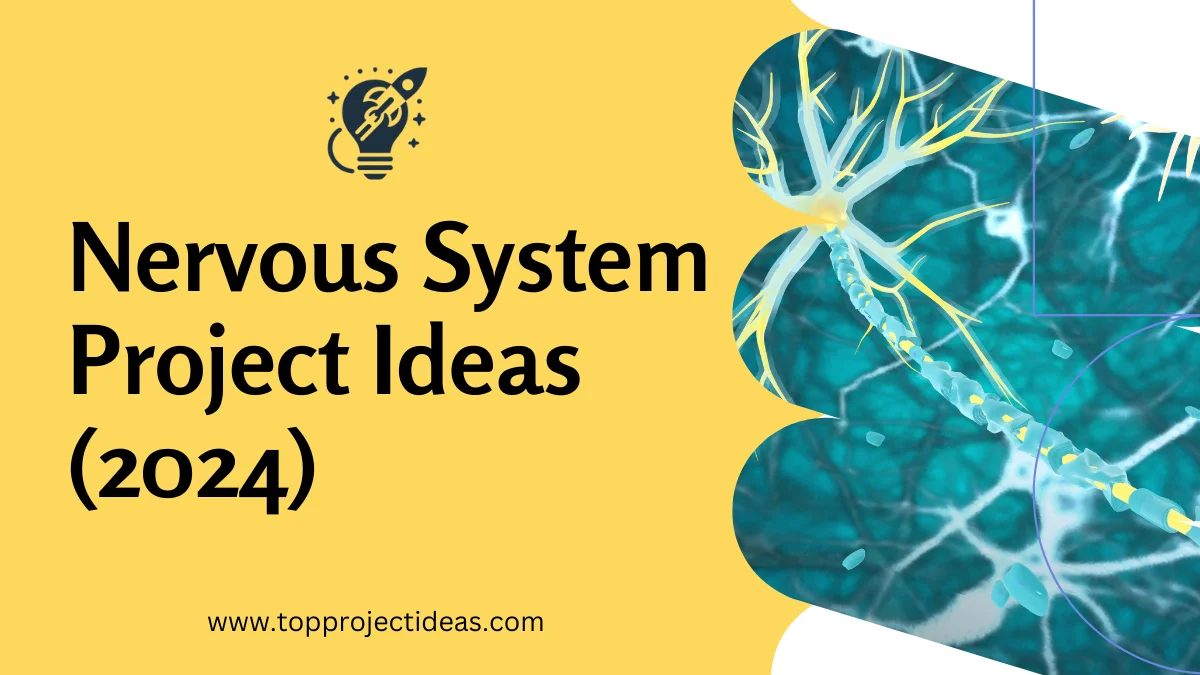The nervous system is like a busy network of special cells called neurons. They send messages between our brain and the rest of our body.
This system controls lots of things, like how we move, feel, and think. It’s split into two parts: the central nervous system (which is the brain and spinal cord) and the peripheral nervous system (all the nerves that spread out from the brain and spinal cord).
Trying out “Nervous System Project Ideas” can be really fun and teach you a lot. These projects let students get hands-on with exploring how this important system works.
Latest Nervous System Project Ideas
The nervous system is a complicated network that manages and coordinates different bodily parts. Exploring this intricate system can provide valuable insights and deepen our understanding.
- Build a 3D model of the brain and label its parts (cerebrum, cerebellum, brain stem).
- Create a poster showing how neurons send messages with electrical and chemical signals.
- Test your reaction time to see how fast neurons send signals.
- Make a game about protecting the nervous system from injuries or diseases.
- Draw the different types of neurons (sensory, motor, interneurons) and their jobs.
- Show how reflexes work with a demonstration like the knee-jerk reaction.
- Study how the senses (sight, sound, touch, taste, smell) connect to the nervous system.
- Explore how the autonomic nervous system controls heartbeat and breathing.
- Create a model showing how the spinal cord sends messages between the brain and the body.
- Discuss how concussions affect the nervous system and how to prevent them.
- Learn about neurotransmitters like dopamine and serotonin in mood and behavior.
- Study how drugs or alcohol affect the nervous system.
- Explore prosthetic limbs controlled by signals from the brain.
- Show how the nervous system controls muscle movements like walking or throwing a ball.
- Study the nervous system’s role in sleep and dreaming.
- Create a game or activity to improve hand-eye coordination.
- Discuss how the nervous system helps with learning and memory.
- Explore how stress affects the nervous system and ways to manage it.
- Study how the nervous system controls body temperature and other processes.
- Learn about brain-computer interfaces that help people with disabilities.
- Discuss ethical issues in nervous system research and treatments.
- Study neurological disorders like Alzheimer’s, Parkinson’s, or multiple sclerosis.
- Learn how the nervous system helps with emotion regulation and emotional intelligence.
- Create a model showing how the nervous system sends pain signals.
- Discuss the importance of good nutrition for a healthy nervous system.
- Explore virtual reality in studying and treating nervous system disorders.
- Study how the nervous system controls balance and coordination.
- Learn about stem cell research for treating nervous system injuries or diseases.
- Explore how exercise benefits the nervous system.
- Study how the nervous system helps the body’s immune response and healing.
- Discuss brain-to-brain communication technology and its uses.
- Create a model showing how the nervous system responds to light, sound, or touch.
- Study the nervous system’s role in circadian rhythms and sleep-wake cycles.
- Explore transcranial magnetic stimulation (TMS) in treating neurological conditions.
- Discuss how environmental factors (pollution, radiation) affect the nervous system.
- Create an interactive game or activity to teach about the nervous system.
- Study how the nervous system responds to stress and chronic stress effects.
- Explore deep brain stimulation (DBS) in treating Parkinson’s or OCD.
- Discuss gene therapy for inherited neurological disorders.
- Create a model showing how the nervous system processes information from the senses.
- Study the nervous system’s role in the fight-or-flight response.
- Explore neurofeedback in treating ADHD or anxiety.
- Discuss ethical issues in using neuroenhancement technologies.
- Create a model showing how the nervous system controls action in animals.
- Study how the nervous system helps with body repair and regeneration.
- Explore optogenetics in studying and holding neural circuits.
- Learn about brain-computer interfaces in restoring lost functions.
- Create a model showing how the nervous system processes pain signals.
- Study how the nervous system reacts to injury or infection.
50. Explore neuroimaging techniques (fMRI, PET) in studying the brain.
Engaging in these projects fosters a deeper understanding of the nervous system. It also cultivates valuable skills like critical thinking and scientific inquiry.
Also Read: 100 Unique SUPW Project Ideas For School Students (2024)
Why Nervous System Project Ideas Are Great for Students?
The nervous system is the amazing control center of our body, like a giant message network. It lets us see, hear, feel, move, and even think! But how does it all work? Nervous system projects can be a fun way to learn more about this fascinating system.
Here’s why diving into nervous system project ideas is a great idea for students:
Learning by Doing: Textbooks are helpful, but sometimes you learn best by getting your hands dirty! Projects let you build models, conduct experiments, or create presentations, making the nervous system come alive. It’s like stepping into a real-life science adventure!
Thinking Like a Scientist: Projects encourage you to ask questions, research for answers, and figure things out. You become a mini-scientist, testing your knowledge and making connections between different ideas. This approach helps you understand the nervous system much better.
Spark Creativity: Projects are your chance to be creative! You might build a giant model brain out of clay, create a comic book about neurons, or write a song about reflexes. The possibilities are endless! By using your imagination, you’ll have a blast learning and remembering the information for a long time.
So, the next time you have a nervous system project, remember – it’s not just about getting a good grade. It’s about becoming a science whiz, a creative thinker, and unlocking the mysteries of your own amazing body!
Tips for Making a Great Nervous System Project
Doing a project on the nervous system can be fun and exciting. Here are some easy steps to help you make a great project:
Pick a Cool Topic
Choose a part of the nervous system that you think is interesting. This will make your project more fun to work on.
Do Good Research
Find good books, articles, and websites with information about your topic. Take notes while you read to remember important details.
Plan Your Project
Decide how you want to show what you’ve learned. You can make a model, do an experiment, or create a poster. Plan what you need and what you want to include.
Add Hands-On Activities
Make your project special by including hands-on activities. You could build a model of the brain or nerves or do a simple experiment to show how the nervous system works.
Explain Clearly
Use simple words to explain your topic so everyone can understand. Use pictures, diagrams, or videos to help explain. Practice talking about your project so it makes sense.
Have Fun and Learn
Enjoy learning about the nervous system, and find fun ways to share what you know. The more fun you have, the better your project will be.
It’s okay to make mistakes. That’s how we learn. Keep trying and focus on learning more about the nervous system. You can do it! Good luck!
5 Tips for Finding a Great Nervous System Project Ideas
The nervous system is a fascinating and complex part of the human body. It controls and coordinates almost all of our bodily functions. Finding a great project related to the nervous system can be an exciting challenge.
Identify Your Interests
Make a list of the specific areas of the nervous system that interest you the most. Do you want to explore the brain, the spinal cord, or the nerves that spread out to other parts of the body? Narrow your focus to ensure your project is not too big and aligns with the things you are most curious about.
Look for AI-Powered Resources
Use the power of artificial intelligence (AI) to help with your research. Many online databases and websites now use AI to help users find relevant information more easily. AI can also help in analyzing data and spotting patterns.
Collaborate with Experts
Reach out to professionals in the field, such as brain doctors, nervous system scientists, or researchers. They can provide valuable insights, guidance, and possibly even mentorship for your project. Working together with experts can improve the quality and accuracy of your work.
Consider Real-World Applications
Think about how your project could contribute to understanding or treating disorders of the nervous system. Projects with practical applications tend to be more engaging and impactful.
Stay Curious and Adaptable
As you work on your project, be ready to adjust your approach based on new information or unexpected findings. Keeping an open and curious mindset will allow you to explore paths you may not have initially considered.
Remember, a great nervous system project requires dedication and perseverance. With the right resources and mindset, you can make valuable contributions to this fascinating field.
Final Words
The nervous system project ideas help students understand the complexities of neurosciences better and also make them more interested in finding out new things.
Through practical exercises, experiments, and fieldwork, young minds set off to find answers to various questions surrounding brains and their complex web of nerves.
In addition, these projects would promote critical thinking, creativity as well as teamwork while demonstrating how neuroscience concepts apply in real life.
During this exploration of the nervous system, alongside knowledge expansion, learners acquire vital abilities that will be helpful in all aspects of their life at school as well as beyond.
FAQs
Are there any project ideas that are appropriate for younger students?
This can be achieved by either constructing a taste bud model with different flavored zones or building a simple nerve impulse pathway.
Is it possible to concentrate my project on one part of the nervous system?
Sure! Consideration may be given to the study of the structure and function of the brain, spinal cord, or even individual cranial nerves.
Can I do projects that use technology?
Definitely! Researching brain-computer interfaces or making a neuron model using electrical circuits.

I’m Isla Campbell, a creative and passionate professional with over 8 years of experience in education and project-based learning. I enjoy coming up with smart, helpful project ideas that inspire students and support teachers. I’m skilled at doing research, finding what works best, and turning ideas into successful learning experiences. I also love working with others, staying organized, and making sure every project is done well and on time. Let’s team up to turn great ideas into real results!
